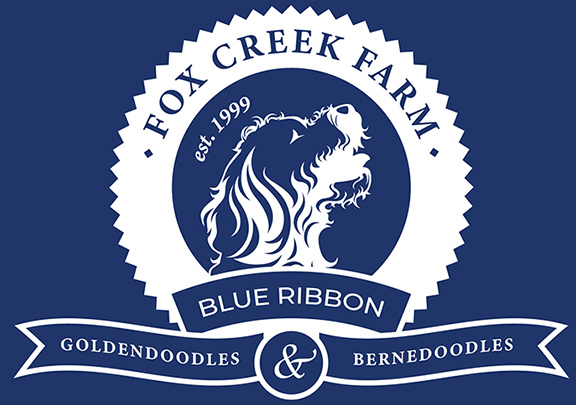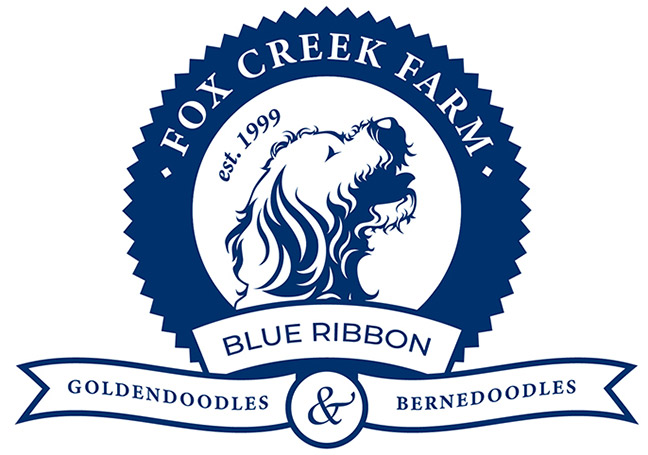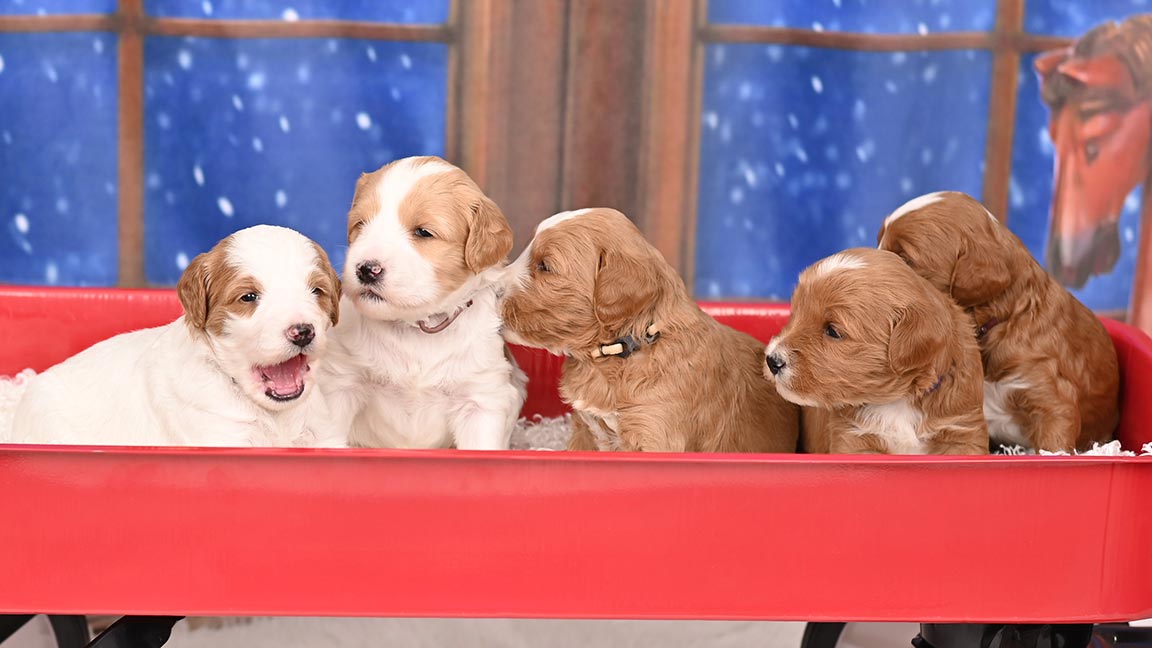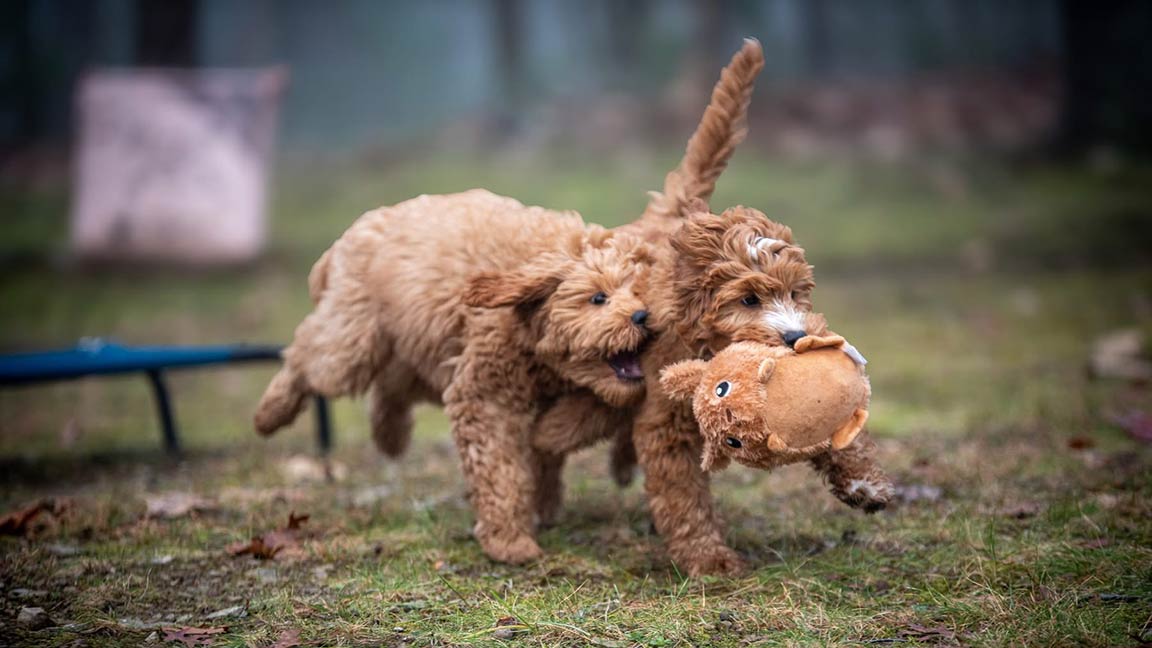
What are F1B Goldendoodles, and are they Hypoallergenic?
Hello, fellow dog lovers! If you’re here, you’re considering adopting a fluffy friend into your family or just curious about the wide world of dog breeds. Among the many types of dogs, a hybrid breed has been capturing hearts around the world – the charming Goldendoodles. Goldendoodles, a cross between the friendly Golden Retriever and the intelligent Poodle, have been popular for their hypoallergenic coats and adorable looks.
But did you know there are different types of Goldendoodles, each with unique characteristics? Among these, the F1B Goldendoodle holds a particular spot, and that’s the generation we will focus on today. But before we dive into the fascinating world of F1B Goldendoodles, let’s briefly cover the main types of Goldendoodles:
- F1 Goldendoodles: This is the first generation of Goldendoodles, bred from a purebred Golden Retriever and a purebred Poodle. They have a 50/50 mix of genes from both parent breeds.
- F1B Goldendoodles: This type of Goldendoodle is bred from an F1 Goldendoodle and a purebred Poodle. This gives them more Poodle genes (75% Poodle and 25% Golden Retriever). You could also go that direction and breed an F1 Goldendoodle and a purebred Golden Retriever. More Golden Retriever genes (75% Golden Retriever and 25% Poodle). For these reasons, it can sometimes be difficult to know what to expect as far as allergies and no shed are concerned.
- F2 Goldendoodles: These are second-generation Goldendoodles, bred from two F1 Goldendoodles. Their genetic makeup is still 50% Golden Retriever and 50% Poodle. Still, their characteristics can vary more due to the mixing of genes.
This blog will explore everything you need to know about F1B Goldendoodles, their hypoallergenic nature, and the importance of finding a reputable breeder. So, without further ado, let’s get started!
Unraveling the Goldendoodle Generations
When considering Goldendoodle, one of the first things to understand is the meaning behind the terms ‘F1’, ‘F2’, and ‘F1B’. These labels provide a glimpse into a Goldendoodle’s lineage, shedding light on its potential traits and characteristics. Let’s take a closer look at these Goldendoodle generations:
- F1 Goldendoodle: This is the first-generation Goldendoodle, resulting from breeding a purebred Golden Retriever with a purebred Poodle. Here’s what you should know about them:
- Genetic Makeup: They have an equal share of genes from both parent breeds – 50% from the Golden Retriever and 50% from the Poodle.
- Coat Type: F1 Doodles often have wavy or shaggy coats. The coat may shed somewhat, although typically less than a purebred Golden Retriever.
- Appearance: They exhibit a healthy blend of both breeds, resulting in a charming mix of traits that Goldendoodle enthusiasts adore.
- F1B Goldendoodle: The generation we focus on today, F1B Doodles, results from breeding an F1 Goldendoodle back to either a purebred Poodle or a purebred Golden Retriever. This gives them unique characteristics:
- Genetic Makeup: With 75% Poodle and 25% Golden Retriever genes or 75% Golden Retriever and 25% Poodle genes, F1B Goldendoodles will have more of the traits of the parent contributing to the 75% gene pool, which can influence their appearance, coat type, and hypoallergenic nature.
- Coat Type: They can have a curly, wavy, or straight coat that is more likely to be hypoallergenic if one of the parents is a Poodle and less hypoallergenic if one of the parents is a Golden Retriever. If one parent is a Poodle, about half of each litter should have a low-to-shedding coat. If one parent is a Golden Retriever, all the puppies will shed some, and about half will be heavy shedders.
- Appearance: F1B Goldendoodles can have the same diverse looks found in the F2 generation. However, if one parent is a Poodle, you will find a stronger Poodle resemblance and, many times, a curly coat. If one parent is a Golden Retriever, coats will likely be straight, and the bone structure and build will be more dense.
- F2 Goldendoodle: These are second-generation Goldendoodles, bred by mating two F1 Goldendoodles. Here’s a quick rundown:
- Genetic Makeup: Despite being second generation, their genetic distribution remains 50% Golden Retriever and 50% Poodle.
- Coat Type: Their coat can vary widely, ranging from straight to curly, and some will be non-shedding while others will shed like a Golden Retriever.
- Appearance: Physical characteristics can vary more in this generation, resulting in a more diverse range of appearances.
A key point to remember is that multigen Goldendoodles, which includes all generations deeper than the F2 Doodles, can have far more predictable coats and hypoallergenic qualities if bred by a reputable breeder. Breeding practices significantly influence the traits and health of the puppy, which is why finding a knowledgeable, responsible breeder is critical.
In the next section, we’ll delve into the physical characteristics of the F1B Goldendoodle in more detail and discuss how their unique genetic makeup impacts their appearance. Stay tuned for more on our delightful four-legged friends!
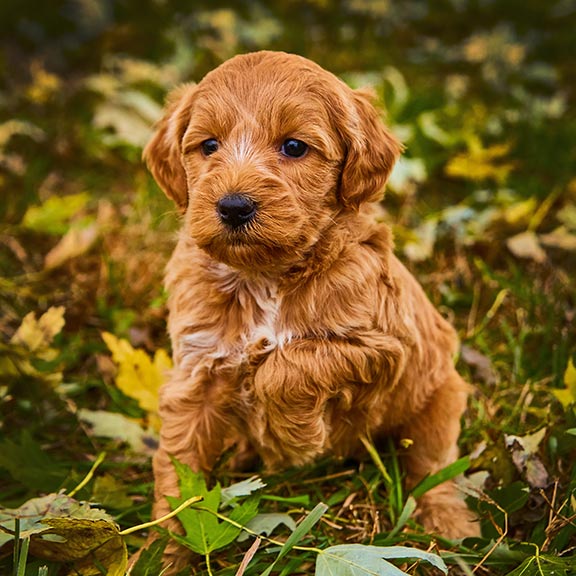
Appearance and Physical Characteristics of the F1B Goldendoodle
The F1B Goldendoodle is often described as the teddy bear among Goldendoodles when one parent is a Poodle, thanks to its charming physical features. It is much more common for an F1B Goldendoodle to be produced by breeding an F1 Goldendoodle back to a Poodle, so that is what we will concentrate on moving forward. This generation stands out due to its unique blend of genes that result in distinctive characteristics. Let’s explore the appearance and physical features of F1B Goldendoodles:
- Size: Like other Goldendoodles, the size of F1B Goldendoodles can vary significantly based on the size of their Poodle parent. They can range from petite/miniature (15-35 pounds) to medium (36-50 pounds) to standard (50+ pounds).
- Coat Type: The F1B Goldendoodle is known for its beautiful, often hypoallergenic coat. Here’s what you should know:
- Texture: The coat can vary between wavy and curly, typically leaning towards the curly side due to the dominance of Poodle genes. This curly coat contributes to the teddy bear look that F1B Goldendoodles are known for.
- Shedding: Only 50% of F1B Goldendoodles will inherit two furnishing genes, while the other 50% will only inherit a single furnishing gene. Those with two furnishing genes are less likely to shed, making them more suitable for allergy sufferers. However, DNA testing on each individual puppy is necessary to know which puppies have this higher chance of being non-shedding.
- Color: F1B Goldendoodles can come in various colors, including cream, gold, red, black, chocolate, and even multi-colors, like phantom, merle, or parti. Their rich array of colors adds to their aesthetic appeal.
- Physical Build: F1B Goldendoodles typically possess a balanced, athletic build inherited from their parent breeds. They are great for families who enjoy outdoor activities, as they are usually active, agile, and love to play.
F1B Goldendoodles’ physical characteristics make them a delightful addition to any family. They not only inherit the beauty and elegance of their parent breeds but also their intelligence and friendly temperament, making them an excellent choice for a family pet.
In our next section, we’ll explore the hypoallergenic nature of the F1B Goldendoodle’s coat and why this characteristic is a boon for many families, especially those with allergy sufferers. So, keep reading for some fascinating insights!
All About the Hypoallergenic Coat
The hypoallergenic nature of the F1B Goldendoodle’s coat is one of the most appealing characteristics of this breed, particularly for households with allergy sufferers. Let’s dive deeper into what makes their coat unique and why it is often considered hypoallergenic:
- Understanding Hypoallergenic Coats: Hypoallergenic doesn’t mean entirely allergen-free. It means the breed is less likely to cause allergic reactions, often due to less shedding of fur and dander.
- The F1B Goldendoodle’s Hypoallergenic Coat: Because F1B Goldendoodles inherit half their genes from an F1 Goldendoodle, there is a 50/50 chance they will be low to non-shedding. Here’s what you should know:
- Less Shedding: If having a hypoallergenic Goldendoodle is important to you and your family, DNA testing on every puppy is required. Only those puppies that inherited two furnishing genes will result in fewer allergens around your home, which can help alleviate allergic reactions.
- There is a general misconception that F1B’s are all considered to be a good choice for those suffering from dog allergies. This is only true for about 50% of all F1B Goldendoodles. It is also a misconception to rely on curly coats to be non-shedding. Goldendoodles can have high-shedding curly coats just the same as they can have non-shedding straight coats. It all depends on the number of furnishing genes each puppy inherits and has nothing to do with the texture of the coat.
- Maintaining the Coat: Despite its possible hypoallergenic nature, the F1B Goldendoodle’s coat requires regular grooming to keep it healthy and tangle-free. Regular brushing and occasional professional grooming can help maintain the coat’s health and appearance.
- A Word of Caution: Although F1B Goldendoodles are sometimes hypoallergenic, allergies can be unpredictable. It’s essential to spend some time with the breed before making a long-term commitment if you or someone in your household has pet allergies. *
*Although it is important to spend time with the breed before deciding, most breeders do not allow visiting of their puppies because visitors can easily track in germs that can be deadly to puppies. We recommend being wary of places that do allow visitation of puppies. Most reputable breeders can allow you to visit virtually using Zoom, FaceTime, and other video programs.
Understanding the possible hypoallergenic nature of F1B Goldendoodles can be particularly beneficial if you or your family members are allergy sufferers. Next, we will delve into the health aspects of the F1B Goldendoodle, exploring common health issues and how their unique genetic makeup can influence their health. Stay tuned for more insights into this delightful breed!

Health Aspects of the F1B Goldendoodle
F1B Goldendoodles, like any dog breed, can be prone to specific health issues. However, their mixed-breed nature often results in a phenomenon known as ‘hybrid vigor‘, which can make them healthier than their purebred counterparts. Let’s dive into the health aspects of F1B Goldendoodles:
- Hybrid Vigor: This term explains the increased vitality and health that mixed-breed dogs often exhibit. It results from these crossbreeds’ genetic diversity compared to purebred dogs.
- Diverse Genetic Pool: In the case of F1B Goldendoodles, the Poodle and Golden Retriever mix provides a broader gene pool, which can help minimize the chances of inheriting specific genetic health problems from either parent breed.
- Healthier Offspring: This genetic diversity can result in Goldendoodles being generally more beneficial and having a longer lifespan compared to some purebred dogs.
- Common Health Issues: Despite the advantage of hybrid vigor, F1B Goldendoodles can still be prone to specific health problems. Some common ones include hip dysplasia, certain skin conditions, eye diseases, and heart conditions. Here are some ways to mitigate these issues:
- Reputable Breeder: Finding a reputable breeder is crucial, as they should screen their breeding dogs for these common health problems. They should also provide certified health clearances for the parents.
- Routine Vet Checkups: Regular vet visits and a healthy diet can help ensure your F1B Goldendoodle stays in peak health.
Choosing an F1B Goldendoodle or any dog is a significant decision, and understanding their health is vital. Now that we’ve covered the health side let’s move on to a practical aspect – finding Goldendoodle puppies for sale and how to choose the right one. Keep reading to embark on the exciting journey of choosing a Goldendoodle puppy!
Finding a Goldendoodle Puppy: Tips and Tricks
Bringing a Goldendoodle puppy home is a rewarding and exciting experience. But finding a reputable breeder, especially for multigen Goldendoodles, can be daunting. Here are some tips and pointers to guide you in your search for the perfect Goldendoodle puppy:
Finding a Reputable Goldendoodle Breeder:
- Do Your Research: Many breeders are out there, but not all are reputable. Start your search with breed-specific clubs or websites, like the Goldendoodle Association of North America (GANA). They often have directories or lists of reputable breeders.
- Ask the Right Questions: When speaking with breeders, ask about their breeding practices, health testing for parent breeds, and socialization practices for the puppies.
Remember, adopting a dog is a long-term commitment. Ensure you are ready for the responsibility that comes with it. In the next section, we’ll wrap up our guide with final thoughts on F1B Goldendoodles. So, stay tuned!
Final Thoughts: Embracing the F1B Goldendoodle Journey
The decision to welcome an F1B Goldendoodle into your home is significant and filled with anticipation and joy. Here, we’ll share some final thoughts and reflections:
- Unique Blend: The F1B Goldendoodle is a unique mix of 75% and 25% Golden Retriever, offering a perfect blend of the Poodle’s hypoallergenic coat and the Golden Retriever’s endearing personality.
- Allergy-Friendly: Only about 50% possess a hypoallergenic coat, making a properly bred multigen Goldendoodle a better choice for households with allergy sufferers.
- Health Matters: While they can still be susceptible to some health issues, multigen and F1B Goldendoodles, if bred by a reputable breeder, often have better health and vitality.
- Finding the Perfect Puppy: Bringing a Goldendoodle puppy home requires careful research, especially in finding a reputable breeder who prioritizes health and temperament.
Before we wrap up, it’s crucial to remember that while this guide provides a general overview, every dog is an individual. The key is to embrace your Goldendoodle’s uniqueness and cherish the unforgettable memories you will undoubtedly create together.
From understanding the genetic makeup of your F1B Goldendoodle to the joy of bringing a new furry family member home, we hope this guide has been informative and helpful in your Goldendoodle journey.
Remember, the bond you’ll form with your Goldendoodle is extraordinary, filled with love, warmth, and delightful surprises along the way. Enjoy the journey!
